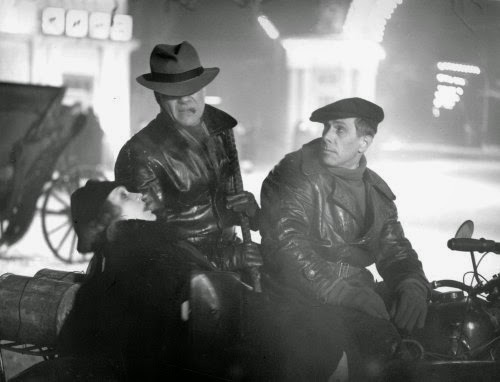By Joe Bendel. How can you be nostalgic for the bad times? Because they are the old times. For instance, our narrator looks back rather fondly on the early days of Stalinism. He and his father were fortunate to share their flat with the local police constable. That meant there were only five (and later six) people crammed into the apartment. How spacious. Even without depicting the Stalinist terror, there is still plenty of scarcity and absurdity in Aleksei Guerman’s My Friend Ivan Lapshin, which screens as part of a mini-Guerman (sometimes translated as German) retrospective now running at Anthology Film Archives in conjunction with the premiere theatrical release of Guerman’s Hard to be a God.
There is not much sugar in this sleepy village of revolutionary fervor, but there always seems to be some in Lapshin’s flat. The town will also get a treat in the form of a traveling agitprop stage performance. The show is a bad as it sounds, but Lapshin still falls for Natasha Adasova, a demur featured actress. They will have some laughs together, but unfortunately, it will be Lapshin’s suicidal journalist friend Khanin who turns her head.
However, Lapshin has another obsession to fall back on: capturing the dreaded Solovyey gang. It is not clear just what crimes the Solovyey outfit has committed, but their (comparative) liberty rankles Lapshin. Frankly, they seem to be born out of the same cloth of economic desperation that gave rise to Bonnie and Clyde—and their ability to evade justice (probably due to their considerable local support) arguably undercuts the state’s authority.
One thing is certain, everyone spends a good deal of time in queues, struggling with shortages, except Lapshin, who goes out of his way to bust black market firewood peddlers. Yet, somehow he seems like a decent fellow, in a rigid, stentorian sort of way, perhaps because we might guess what sort of trials and travails lie ahead for him.

Although Friend is far more accessible and narrative-driven than HTBAG, the vibes of the respective films are not so very different. In both cases, characters exist in a state of constant chaos, yet they live in an environment of near total stasis. Both films are distinguished by their striking black-and-white cinematography, but there is something about the dreamy vibe that keeps us at arm’s length.
Andrei Boltnev is commandingly tragic as the severe Lapshin, while Andrey Mironov makes a strangely charismatic sad sack as Khanin. Nina Ruslanova’s Adasova also brings sufficient heat to let us buy into their love triangle. Indeed, it is quite a fine example of ensemble acting, but it is still a rather odd film to watch, because Guerman is being so deliberately cagey with his allegorical implications, for obvious reasons.
Nevertheless, Friend was duly banned by the authorities for fourteen years, finally seeing the light of day in the late 1980s. Reportedly, it was deemed an insufficiently heroic portrayal of the early days of socialism building. It was also an awkward, sometimes even sarcastic reminder they had been building socialism for five decades, but things were as crummy as ever. Recommended as a fascinating historical document not without its own artistic merits, My Friend Ivan Lapshin screens again this coming Monday (2/9), as part of the Guerman series at Anthology Film Archives.
LFM GRADE: A-
Posted on February 4th, 2015 at 8:27pm.